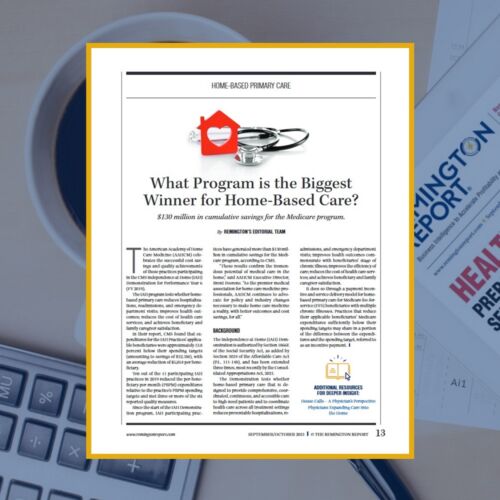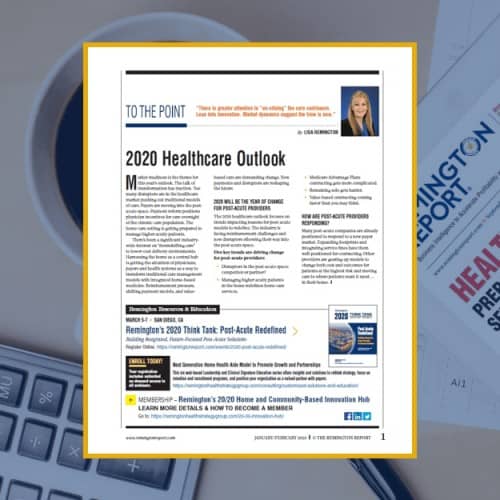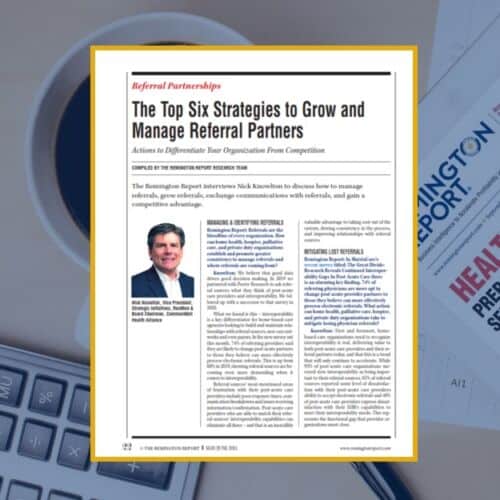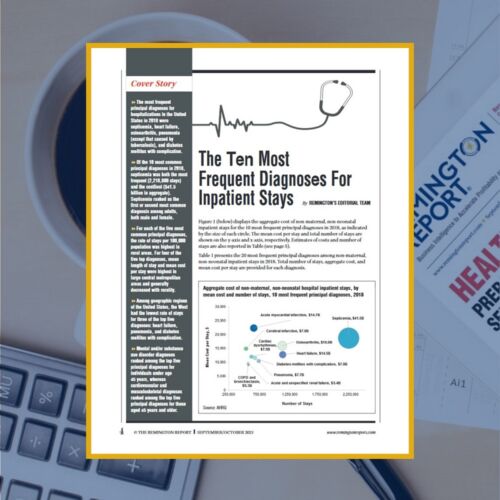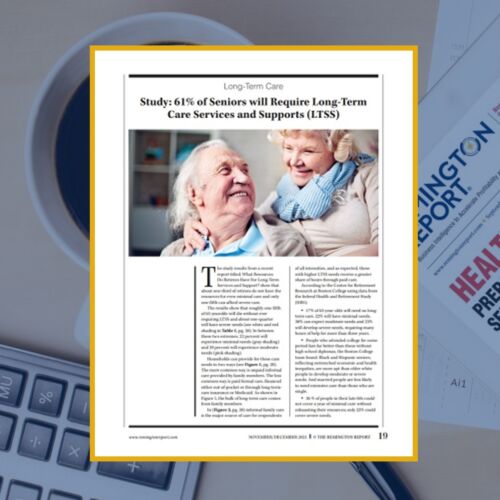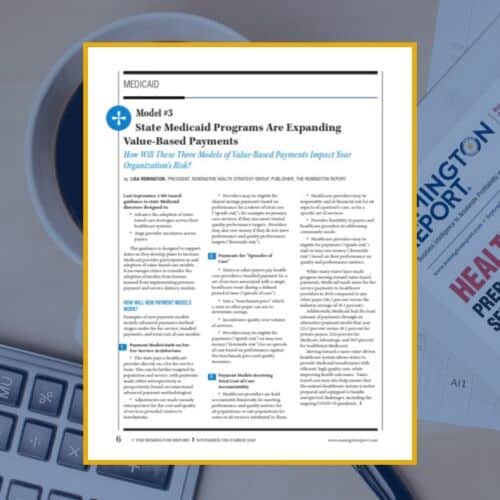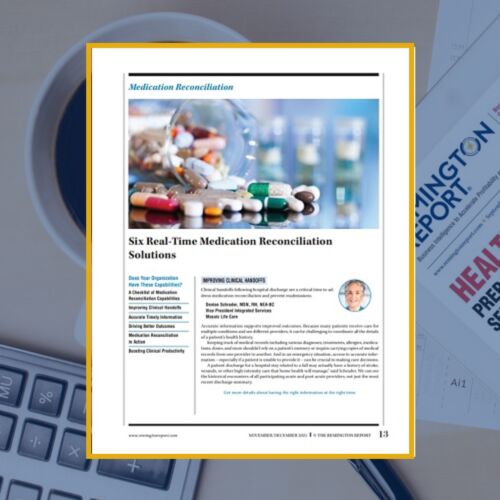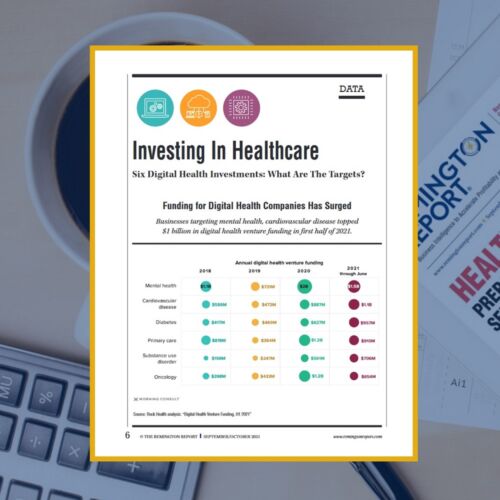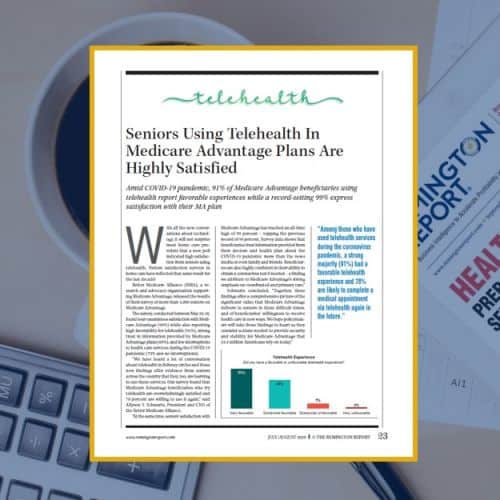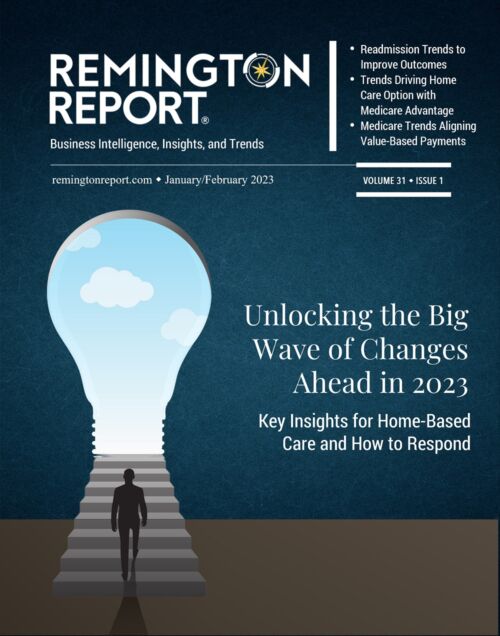-
 Eighty percent of ACOs reported using home visits for some of their patients, with larger ACOs more commonly using home visits. Under alternative payment models ? including accountable care organization (ACO) contracts ? providers may have greater motivation to improve care delivery for patients with complex clinical needs because they are responsible for the patients? total cost of care. This article is free to 1-Year Classic and 2-Year Premium subscribers.
Eighty percent of ACOs reported using home visits for some of their patients, with larger ACOs more commonly using home visits. Under alternative payment models ? including accountable care organization (ACO) contracts ? providers may have greater motivation to improve care delivery for patients with complex clinical needs because they are responsible for the patients? total cost of care. This article is free to 1-Year Classic and 2-Year Premium subscribers. -
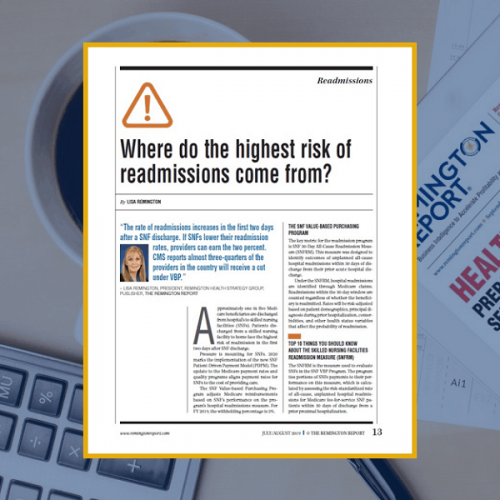 The rate of readmissions increases in the first two days after a SNF discharge. If SNFs lower their readmission rates, providers can earn the two percent. CMS reports almost three-quarters of the providers in the country will receive a cut under VBP. This article is free to 1-Year Classic and 2-Year Premium subscribers.
The rate of readmissions increases in the first two days after a SNF discharge. If SNFs lower their readmission rates, providers can earn the two percent. CMS reports almost three-quarters of the providers in the country will receive a cut under VBP. This article is free to 1-Year Classic and 2-Year Premium subscribers. -
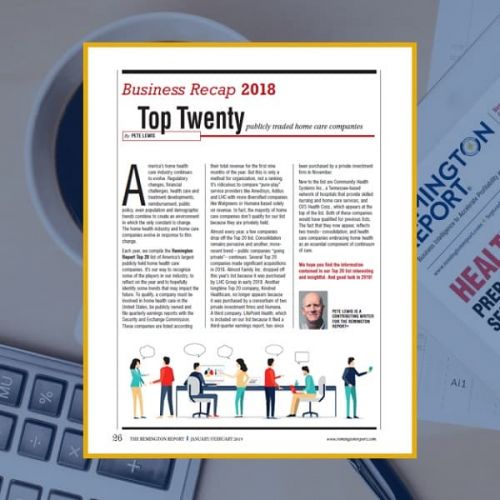 Each year, we compile The Remington Report Top 20 list of America?s largest publicly held home healthcare companies. It?s our way to recognize some of the players in our industry, to reflect on the year and to hopefully identify some trends that may impact the future. This article is free to 1-Year Classic and 2-Year Premium subscribers.
Each year, we compile The Remington Report Top 20 list of America?s largest publicly held home healthcare companies. It?s our way to recognize some of the players in our industry, to reflect on the year and to hopefully identify some trends that may impact the future. This article is free to 1-Year Classic and 2-Year Premium subscribers. -
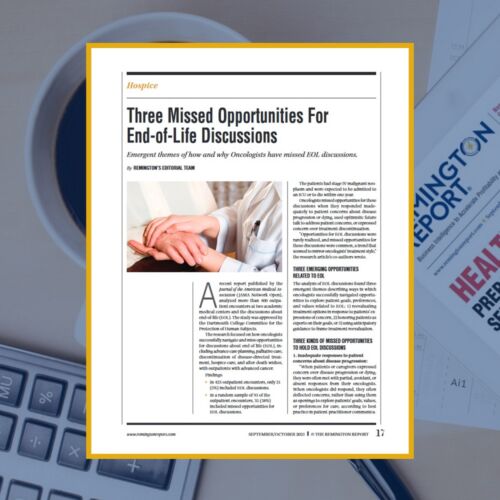 Recent research discusses the missed opportunities for discussions about end-of-life, including advance care planning, palliative care, discontinuation of disease-directed treatment, hospice care, and after-death wishes, with outpatients with advanced cancer. This article is free to 1-Year Classic and 2-Year Premium subscribers.
Recent research discusses the missed opportunities for discussions about end-of-life, including advance care planning, palliative care, discontinuation of disease-directed treatment, hospice care, and after-death wishes, with outpatients with advanced cancer. This article is free to 1-Year Classic and 2-Year Premium subscribers. -
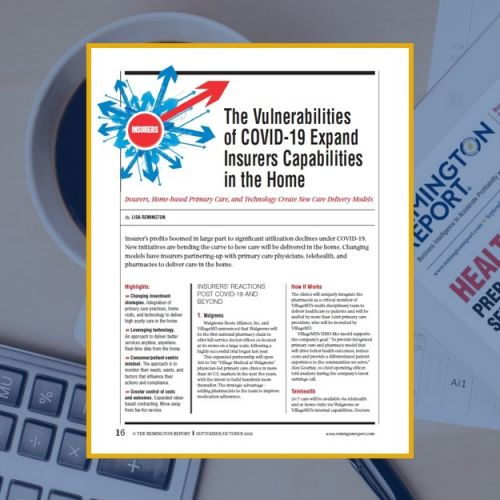 Insurers' strategies to provide greater services in the home are moving rapidly. Changing models have insurers partnering-up with primary care physicians, telehealth, and pharmacies to deliver care in the home. We provide insights to insurers' reactions post COVID-19 and beyond. This article is free to 1-Year Classic and 2-Year Premium subscribers.
Insurers' strategies to provide greater services in the home are moving rapidly. Changing models have insurers partnering-up with primary care physicians, telehealth, and pharmacies to deliver care in the home. We provide insights to insurers' reactions post COVID-19 and beyond. This article is free to 1-Year Classic and 2-Year Premium subscribers. -
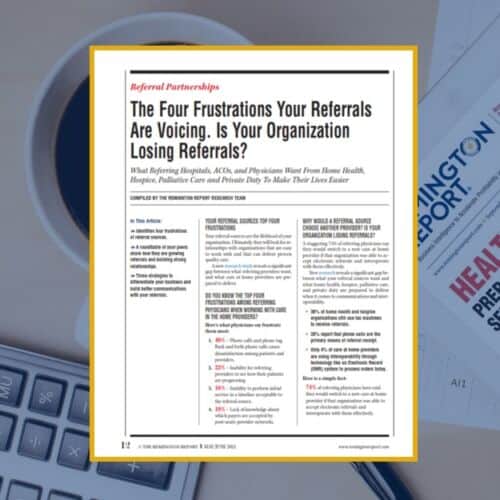 Your referral sources are the lifeblood of your organization. Ultimately, they will look for relationships with organizations that are easy to work with and that can deliver proven quality care. A new research report reveals the four frustrations felt by your referral sources. A roundtable of your peers’ weigh-in with solutions. This article is free to 1-Year Classic and 2-Year Premium subscribers.
Your referral sources are the lifeblood of your organization. Ultimately, they will look for relationships with organizations that are easy to work with and that can deliver proven quality care. A new research report reveals the four frustrations felt by your referral sources. A roundtable of your peers’ weigh-in with solutions. This article is free to 1-Year Classic and 2-Year Premium subscribers. -

This webinar is part of the six-event, on-demand webinar series: Next Generation Home Health Aide Model to Promote Growth and Partnerships
Webinar Summary
The payer market is moving rapidly to identify care in the home models. This presents new opportunities for your organization. In this webinar, we discuss:- The payer market
- Regulatory and policy driving change
- How to meet new market demands
- Case study: Responding effectively to the new payer landscape
Want to purchase the entire series for $499? Click here.
- Webinar #1: The Changing Healthcare Landscape: The New Role of the Home Health Aides
- Webinar #2: How to Expand Payer Partnerships and Meet Their Goals
- Webinar #3: How to Expand the Role of Aides to be Part of an Interdisciplinary Team Member
- Webinar #4: How to Target Interventions to Improve Outcomes
- Webinar #5: How to Size-up Your Organization for Cultural Change
- Webinar #6: How to Boost Quality Scores and Performance Improvement
-
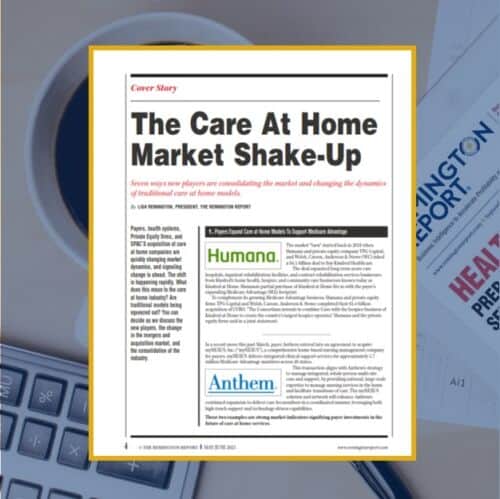 Payers, health systems, Private Equity firms, and SPAC’S acquisition of care at home companies are quickly changing market dynamics, and signaling change is ahead. This is a must-read to understand trends and insights reshaping the future. This article is free to 1-Year Classic and 2-Year Premium subscribers.
Payers, health systems, Private Equity firms, and SPAC’S acquisition of care at home companies are quickly changing market dynamics, and signaling change is ahead. This is a must-read to understand trends and insights reshaping the future. This article is free to 1-Year Classic and 2-Year Premium subscribers. -
 Prior authorizations take time away from patients and interject a third party into the doctor-patient relationship. There are many frustrations with prior authorizations, but the time spent getting payer permission is a common thread among all doctors. The average practice spends more than 15 hours per week total on them. This article is free to 1-Year Classic and 2-Year Premium subscribers.
Prior authorizations take time away from patients and interject a third party into the doctor-patient relationship. There are many frustrations with prior authorizations, but the time spent getting payer permission is a common thread among all doctors. The average practice spends more than 15 hours per week total on them. This article is free to 1-Year Classic and 2-Year Premium subscribers. -
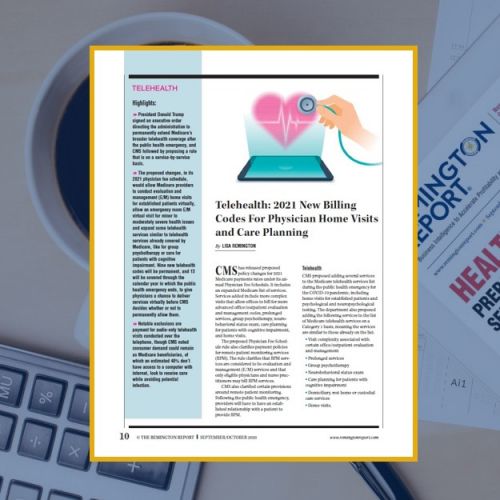 CMS has released proposed policy changes for 2021 Medicare payment rates under its annual Physician Fee Schedule. Telehealth codes allow physicians to bill for home visits and care planning. We dive into the codes and what they mean. This article is free to 1-Year Classic and 2-Year Premium subscribers.
CMS has released proposed policy changes for 2021 Medicare payment rates under its annual Physician Fee Schedule. Telehealth codes allow physicians to bill for home visits and care planning. We dive into the codes and what they mean. This article is free to 1-Year Classic and 2-Year Premium subscribers. -
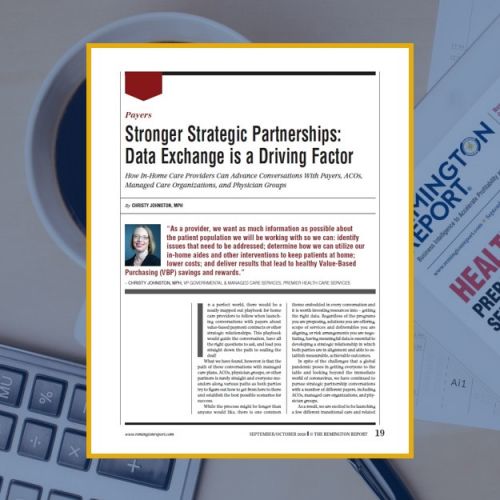 Payers are interested in talking about the data. In particular, they are interested in understanding how home care providers are able to reduce their penalties and increase their rewards in a value-based payment system. Learn how one organization is advancing conversations. This article is free to 1-Year Classic and 2-Year Premium subscribers.
Payers are interested in talking about the data. In particular, they are interested in understanding how home care providers are able to reduce their penalties and increase their rewards in a value-based payment system. Learn how one organization is advancing conversations. This article is free to 1-Year Classic and 2-Year Premium subscribers. -
 Specialists and Home Care Providers: Outcome-Based Relationships to Grow Referrals In this strategy workshop, you will learn 10 ways to enhance outcome-based relationships and ways to build deeper relationships with specialists. Fees
Specialists and Home Care Providers: Outcome-Based Relationships to Grow Referrals In this strategy workshop, you will learn 10 ways to enhance outcome-based relationships and ways to build deeper relationships with specialists. Fees- $412.50
- Purchase both workshops and save 10%: Use coupon code STRATEGYWS at checkout
Add Your Enrollees
Additional enrollees will be enabled upon completion of registration. Company email addresses required. Think Tank programs are open only to provider organizations delivering patient care, including home health care, at-home care, hospice, palliative care, community-based organizations, hospitals, ACOs, managed care organizations, and physicians. Enrollees for the program must be full-time employees of the organization. If you are unsure whether your organization qualifies for Think Tank programs or your organization is a provider that also sells products, services or you are a consultant, then contact us before enrolling. -
 Physicians and Home Care Providers: Outcome-Based Relationships to Grow Referrals In this strategy workshop, you will learn 10 solutions for forging outcome-based relationships and ways to build deeper relationships with physicians. Fees
Physicians and Home Care Providers: Outcome-Based Relationships to Grow Referrals In this strategy workshop, you will learn 10 solutions for forging outcome-based relationships and ways to build deeper relationships with physicians. Fees- $412.50
- Purchase both workshops and save 10%: Use coupon code STRATEGYWS at checkout
- Registration includes enrollment for up to 10 people. Must be enrolled to attend. Business email required for each enrollee.
Add Your Enrollees
Additional enrollees will be enabled upon completion of registration. Company email addresses required. Think Tank programs are open only to provider organizations delivering patient care, including home health care, at-home care, hospice, palliative care, community-based organizations, hospitals, ACOs, managed care organizations, and physicians. Enrollees for the program must be full-time employees of the organization. If you are unsure whether your organization qualifies for Think Tank programs or your organization is a provider that also sells products, services or you are a consultant, then contact us before enrolling. -
 Examine the latest strategies with a focus on focus on care delivery improvement: care transitions, readmission management, care management, and outcomes. You’ll learn how to bridge the silos and develop a culture of trust by aligning the goals and incentives of all stakeholders within healthcare, including ACOs, hospitals/health systems, payers, physicians, and insurers. Tap into fresh thinking to inspire new levels of care delivery improvement. 4-MONTH PROGRAM Registration Open – INCLUDES 4 WEBINARS $1,650 SINGLE FEE INCLUDES 4 ENROLLEES This is an on-demand program.
Examine the latest strategies with a focus on focus on care delivery improvement: care transitions, readmission management, care management, and outcomes. You’ll learn how to bridge the silos and develop a culture of trust by aligning the goals and incentives of all stakeholders within healthcare, including ACOs, hospitals/health systems, payers, physicians, and insurers. Tap into fresh thinking to inspire new levels of care delivery improvement. 4-MONTH PROGRAM Registration Open – INCLUDES 4 WEBINARS $1,650 SINGLE FEE INCLUDES 4 ENROLLEES This is an on-demand program.Add Your Enrollees
Additional enrollees will be enabled upon completion of initial enrollee. Company email addresses required. -
 Telehealth is predicted to be the next big investment for seniors aging in place. The number of seniors requiring additional caregiving and support due to chronic disease will increase from about 14 percent of the senior population in 2010 to 21 percent by 2050, putting the pressure on healthcare providers to improve caregiving platforms. This article is free to 1-Year Classic and 2-Year Premium subscribers.
Telehealth is predicted to be the next big investment for seniors aging in place. The number of seniors requiring additional caregiving and support due to chronic disease will increase from about 14 percent of the senior population in 2010 to 21 percent by 2050, putting the pressure on healthcare providers to improve caregiving platforms. This article is free to 1-Year Classic and 2-Year Premium subscribers. -
 This series provides multi-level staffing solutions to today’s workforce challenges, offering proven, time-tested guidance from a CEO veteran with 30 years of experience in home-based care. A home-based care organization’s greatest asset are clinicians, staff, and managers. How can your organization reduce clinician burnout, improve productivity, create adaptive staffing models, and promote a culture of clinician engagement to increase retention? A powerful webinar series that will help you tackle staffing issues.
This series provides multi-level staffing solutions to today’s workforce challenges, offering proven, time-tested guidance from a CEO veteran with 30 years of experience in home-based care. A home-based care organization’s greatest asset are clinicians, staff, and managers. How can your organization reduce clinician burnout, improve productivity, create adaptive staffing models, and promote a culture of clinician engagement to increase retention? A powerful webinar series that will help you tackle staffing issues.- Webinar #1: Adaptive Staffing Models by Clinical Conditions to Improve Patient Outcomes, Efficiency, and Organizational Capacity
- Webinar #2: Multidisciplinary Team Staffing Models to Improve Retention, Productivity, and Continuity of Care
- Webinar #3: Staffing Strategies for Chronic Care Management to Improve Outcomes
Add Your Enrollees
Additional enrollees will be enabled upon completion of initial enrollee. Company email addresses required. Think Tank programs are open only to provider organizations delivering patient care, including home health care, at-home care, hospice, palliative care, community-based organizations, hospitals, ACOs, managed care organizations, and physicians. Enrollees for the program must be full-time employees of the organization. If you are unsure whether your organization qualifies for Think Tank programs or your organization is a provider that also sells products, services or you are a consultant then contact us before enrolling. -
 Building Stronger Referral Partnerships with Tools, Trends, and Powerful Insights About the Changing Paradigm This online series includes two master classes that are designed to identify opportunities for relationship building, craft compelling value propositions, and offer guidance to better understand quality measures, screening tools, the impact on each of your referral partners, and how you can become a high-engaged partner. REGISTRATION FEE: $800 (Includes 2 Webinars) Online Event Available Now! Registration includes all three webinars, with enrollment for up to 10 people. Must be enrolled to attend. Business email required for each enrollee.
Building Stronger Referral Partnerships with Tools, Trends, and Powerful Insights About the Changing Paradigm This online series includes two master classes that are designed to identify opportunities for relationship building, craft compelling value propositions, and offer guidance to better understand quality measures, screening tools, the impact on each of your referral partners, and how you can become a high-engaged partner. REGISTRATION FEE: $800 (Includes 2 Webinars) Online Event Available Now! Registration includes all three webinars, with enrollment for up to 10 people. Must be enrolled to attend. Business email required for each enrollee.Add Your Enrollees
Additional enrollees will be enabled upon completion of registration. Company email addresses required. Think Tank programs are open only to provider organizations delivering patient care, including home health care, at-home care, hospice, palliative care, community-based organizations, hospitals, ACOs, managed care organizations, and physicians. Enrollees for the program must be full-time employees of the organization. If you are unsure whether your organization qualifies for Think Tank programs or your organization is a provider that also sells products, services or you are a consultant, then contact us before enrolling. -
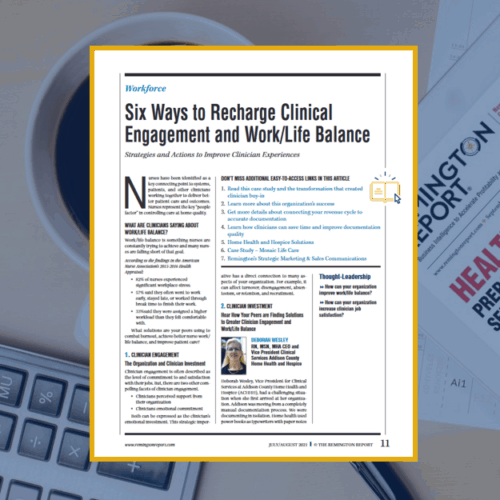 Strategies and actions to improve clinician experiences. Work/life balance is something nurses are constantly trying to achieve, and many nurses are falling short of that goal. What solutions are your peers using to combat burnout, achieve better nurse work/life balance, and improve patient care? This article is free to 1-Year Classic and 2-Year Premium subscribers.
Strategies and actions to improve clinician experiences. Work/life balance is something nurses are constantly trying to achieve, and many nurses are falling short of that goal. What solutions are your peers using to combat burnout, achieve better nurse work/life balance, and improve patient care? This article is free to 1-Year Classic and 2-Year Premium subscribers. -
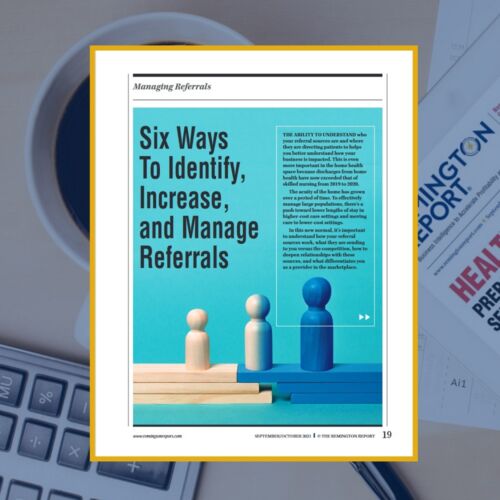 In this new normal, it’s important to understand how your referral sources work, what they are sending to you versus the competition, how to deepen relationships with these sources, and what differentiates you as a provider in the marketplace. This article is free to 1-Year Classic and 2-Year Premium subscribers.
In this new normal, it’s important to understand how your referral sources work, what they are sending to you versus the competition, how to deepen relationships with these sources, and what differentiates you as a provider in the marketplace. This article is free to 1-Year Classic and 2-Year Premium subscribers. -
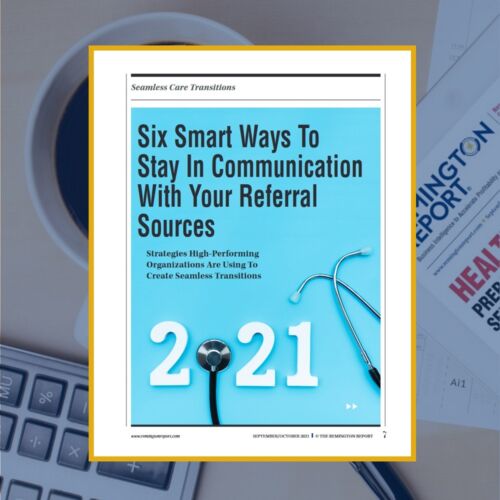 Your referral partners increasingly expect robust communications to make patient transfers as seamless as possible, for both the patient and providers. They will have to make a choice. Ultimately, they will look for relationships with organizations that are easy to work with and that can deliver proven quality care. We provide insights and strategies from high-performing organizations. This article is free to 1-Year Classic and 2-Year Premium subscribers.
Your referral partners increasingly expect robust communications to make patient transfers as seamless as possible, for both the patient and providers. They will have to make a choice. Ultimately, they will look for relationships with organizations that are easy to work with and that can deliver proven quality care. We provide insights and strategies from high-performing organizations. This article is free to 1-Year Classic and 2-Year Premium subscribers. -
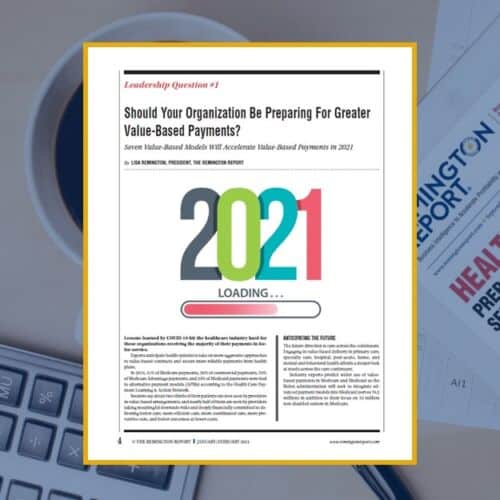 Beginning in 2021, several value-based payment models will begin the shift from fee-for-service to value-based. Earmark this as the transformation of payment reform for care at home providers and how they will be paid in the future. This article is free to 1-Year Classic and 2-Year Premium subscribers.
Beginning in 2021, several value-based payment models will begin the shift from fee-for-service to value-based. Earmark this as the transformation of payment reform for care at home providers and how they will be paid in the future. This article is free to 1-Year Classic and 2-Year Premium subscribers. -
 Market intelligence and breaking down complex market dynamics will help your organization quickly grasp where the care at home industry is headed. The who, what, where, and why the industry is transforming is navigated in this three-virtual-webinar series. Our vast knowledge of the care at home industry and the entire care continuum (including ACOs, insurers, physicians, health systems, and hospitals) will break through the chaos and provide a comprehensive vision to help you lead with insight, plan with vision, and create a growth readiness roadmap. 4-MONTH PROGRAM Registration Open – INCLUDES 4 WEBINARS $1,200 SINGLE FEE INCLUDES 4 ENROLLEES This is an on-demand program.
Market intelligence and breaking down complex market dynamics will help your organization quickly grasp where the care at home industry is headed. The who, what, where, and why the industry is transforming is navigated in this three-virtual-webinar series. Our vast knowledge of the care at home industry and the entire care continuum (including ACOs, insurers, physicians, health systems, and hospitals) will break through the chaos and provide a comprehensive vision to help you lead with insight, plan with vision, and create a growth readiness roadmap. 4-MONTH PROGRAM Registration Open – INCLUDES 4 WEBINARS $1,200 SINGLE FEE INCLUDES 4 ENROLLEES This is an on-demand program.Add Your Enrollees
Additional enrollees will be enabled upon completion of initial enrollee. Company email addresses required. -
Out of stock

Post-Acute Redefined: Building Integrated, Future-Focused, Post-Acute Solutions
MARCH 5-7, 2020 Loews Coronado Bay Resort, Coronado, California
Purchase a spouse ticket to the Thursday, March 5, Welcome Reception for $35
Premium subscribers receive a 10% discount. Click here to learn about the benefits of a premium subscription. Registering more than 2 spouses? Pay for all your spouses here, provide us with registration information on the first two, and we will follow up with you to obtain registration information on the others. -
 Take a strategic approach to evaluating partnership and referral growth opportunities to create better patient-centered care, improved outcomes, and develop deeper engagement strategies to align shared goals and incentives. You’ll be connected to knowledge that expands across the healthcare ecosystem to align initiatives, grow referral relationships, and strengthen partnerships between home-based care and ACOs, hospitals and health systems, physicians, and managed care organizations. 4-MONTH PROGRAM Registration Open – INCLUDES 4 WEBINARS $1,650 SINGLE FEE INCLUDES 4 ENROLLEES This is an on-demand program.
Take a strategic approach to evaluating partnership and referral growth opportunities to create better patient-centered care, improved outcomes, and develop deeper engagement strategies to align shared goals and incentives. You’ll be connected to knowledge that expands across the healthcare ecosystem to align initiatives, grow referral relationships, and strengthen partnerships between home-based care and ACOs, hospitals and health systems, physicians, and managed care organizations. 4-MONTH PROGRAM Registration Open – INCLUDES 4 WEBINARS $1,650 SINGLE FEE INCLUDES 4 ENROLLEES This is an on-demand program.Add Your Enrollees
Additional enrollees will be enabled upon completion of initial enrollee. Company email addresses required.

